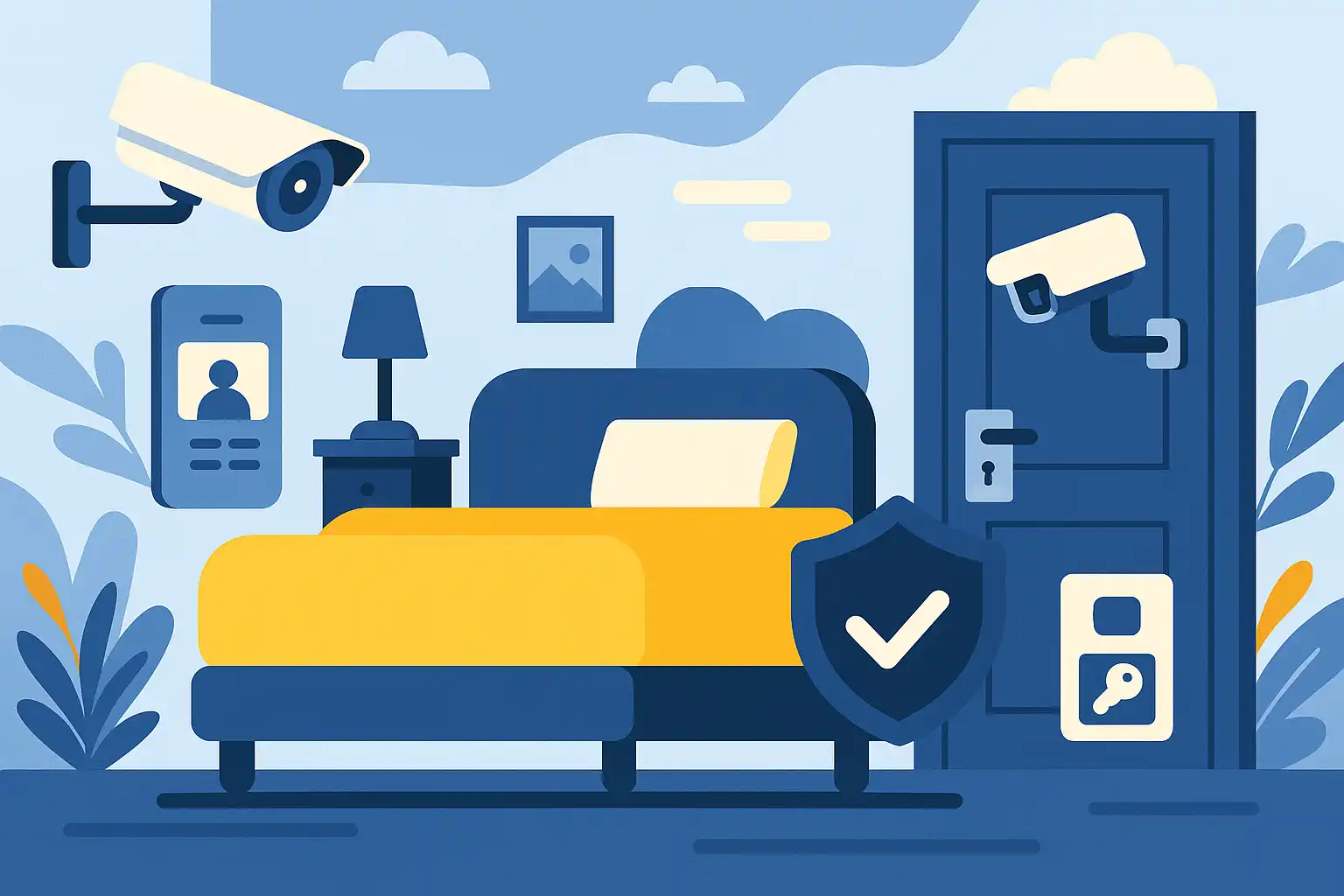Hotel Room Service: Comprehensive Guide for Hoteliers
Oct 7, 2025
 Mika Takahashi
Mika TakahashiPopular Categories
Hotel Technology & InnovationHotel Operations OptimizationDigital MarketingIndustry TrendsRevenue ManagementHospitality Industry
Popular Categories
Trending Post

Hotel Walk Letter Template: Professional Guest Communication

Online Travel Agents: What They Are and How They Work

Hotel Security Systems: Modern Protection Solutions

Hotel Advertising: Complete Guide to Boost Bookings and Revenue

25 Hotel Marketing Strategy Ideas for 2025: Complete Guide

AI Reservation Agent: Revolutionizing Hotel Booking and Guest Experience

PMS Communication: Streamlining Property Management Through Effective Guest Messaging
Table of contents
In the highly competitive hospitality industry, hotel room service plays a vital role in transforming a guest's stay from ordinary to truly memorable. It offers guests the simple luxury of enjoying tasty meals, refreshing drinks, and other amenities right in the comfort and privacy of their own room. Whether you run a cozy boutique hotel or a sprawling luxury resort, having a solid understanding of hotel room service—from its origins and evolution to the day-to-day challenges and exciting innovations—is essential.
This guide covers everything hoteliers need to know about providing, managing, and optimizing room service to delight today’s savvy travelers and boost your property's revenue.
A Brief History of Room Service in Hospitality
Room service has always been a symbol of luxury and personal care in the hotel world. It started in the grand hotels of the late 19th and early 20th centuries as a way to let guests enjoy dining in their rooms without giving up quality. The Waldorf Astoria in New York, for example, is famous for pioneering many modern hospitality features, including formal room service. This set the bar high for luxury hotels everywhere and made hotel room service an essential part of the guest experience.
How Room Service Has Evolved in Modern Hotels
Fast forward to today, and hotel room service has come a long way. What began as simple phone orders has now transformed with technology. Hotels are embracing app-based digital menus, contactless delivery, and mobile ordering to meet guests’ growing demand for convenience, speed, and customization. The COVID-19 pandemic pushed many hotels to adopt these innovations quickly, and now they’re here to stay. Guests can order through in-room tablets, mobile apps, or even voice assistants, making hotel room service more seamless than ever.
Why Hotel Room Service Still Matters for Guest Satisfaction and Revenue
Even with all these changes in how people dine, hotel room service remains a crucial part of the hotel experience. It offers comfort, privacy, and an easy way to enjoy meals without stepping out. For many hotels, especially upscale ones, providing top-notch room service sets them apart from the competition and encourages guests to come back. Plus, it’s a great way to cater to guests with dietary restrictions or special preferences, making their stay feel truly personalized.

What Is Hotel Room Service?
Definition and Purpose
Hotel room service, also known as in-room dining, is the service that lets guests order food, drinks, and other amenities straight to their hotel room or suite. It’s all about convenience, privacy, and personal service—perfect for business travelers, families, or anyone wanting a quiet or romantic meal without leaving their room.
Types of Room Service
- Traditional Room Service: Guests call in their orders, and staff deliver meals on trays or trolleys, sometimes even setting up a table in the room for a more formal experience.
- Trolley Service: Food is served directly from a cart, often used for special occasions or in luxury hotels, adding a touch of theatre to the meal.
- 24-Hour Room Service: Available anytime, day or night, with a full menu to cater to guests’ varied schedules.
- Express Room Service: A quicker option with a limited menu of pre-prepared items, ideal for guests who want fast meals during busy times.
- In-Room Dining Apps: Guests order, track, and pay digitally via mobile apps or tablets, making the process convenient and reducing errors.
How Room Service Differs from Minibar or Grab-and-Go
Unlike minibars or grab-and-go snacks—which are self-service and usually limited to packaged items—hotel room service offers freshly prepared meals delivered by staff, often with a wider menu and personalized touches. Room service lets guests customize their orders, while minibars are fixed and limited.
Benefits of Offering Hotel Room Service
Enhancing Guest Experience and Convenience
Hotel room service lets guests enjoy meals in their own space, whether it’s a romantic dinner, a late-night snack, or a quick business meal. It’s perfect for those who value privacy, flexibility, and relaxation—whether recovering from illness, traveling with kids, or working late.
Boosting Average Revenue Per Occupied Room (RevPOR)
By offering more dining options beyond the hotel restaurant, hotel room service encourages guests to spend more, increasing revenue per guest. Upselling premium dishes, drinks, and special packages through room service can further boost profits. Plus, it can reduce the need for large on-site dining facilities, helping control costs.
Standing Out for 4–5-Star Hotels
High-quality hotel room service is a hallmark of luxury properties, helping them attract discerning guests. Unique offerings like locally sourced menus, themed dining experiences, or personalized touches enhance the hotel’s brand and build guest loyalty.
Creating Upselling Opportunities Through Personalized Service
Staff can suggest premium dishes, alcoholic drinks, or special occasion packages, opening doors for extra revenue. Technology can even personalize recommendations based on guest history, making upselling more effective.
Challenges and Costs of Hotel Room Service
Staffing and Labor Needs
Providing hotel room service means having well-trained staff for taking orders, preparing food, delivering meals, and clearing trays. This often means higher labor costs, especially if offering 24-hour service. Training is key to ensure friendly, efficient service.
Managing Food Waste and Operational Efficiency
Balancing inventory and timely delivery can be tricky. Poor forecasting or mishandled orders can lead to waste. Smart menu planning, portion control, and real-time inventory tracking help keep costs down.
Pricing and Profitability
Hotel room service prices usually include service and delivery fees to cover extra costs, but it’s a balancing act to meet guest expectations while staying profitable. Clear communication about fees helps guests understand the value.
Keeping Food Hot and Fresh
Room service order that arrives hot and looks great requires special equipment like insulated trays and warming carts. Staff must be trained on timing and handling to maintain quality.
Meeting Hygiene and Safety Standards
Hotels need to follow strict food safety and hygiene rules, especially in delivery and handling. Regular training and audits are essential to keep guests safe.

Different Models of Hotel Room Service
Traditional In-Room Dining – Phone Orders
Guests call a dedicated number to order from a menu, with staff coordinating preparation and delivery. This offers personal interaction but can slow down during busy times.
Limited or Express Room Service – Quick and Focused
A smaller menu of items that travel well, designed for faster prep and delivery during peak hours or in budget hotels. It balances convenience and quality.
24-Hour Room Service – Always Available
Round-the-clock staffing and kitchen operations meet guest needs anytime, common in luxury hotels. Maintaining consistent quality and timely delivery is a challenge.
App-Based or Digital Room Service – Mobile Ordering
Guests order through property management systems or in-room tablets, with real-time menu updates and order tracking. This improves convenience and reduces errors.
Outsourced Room Service – Partnering with External Providers
Some hotels team up with third-party food delivery services to offer order room service without the operational burden. This can expand menu options but requires careful quality control.
Keys to Running a Great Hotel Room Service Operation
Smart Menu Design
Offer a balanced variety that’s profitable and travels well. Include options for dietary restrictions like gluten-free, vegan, or halal to cater to all guests.
Smooth Delivery Workflow
Efficient order-taking, kitchen coordination, and timely delivery are critical to keep food fresh and guests happy. Technology can help streamline communication.
Presentation Matters
Meals should be beautifully arranged with attention to plating and garnishes, served on quality dishware to enhance the experience.
Clear Guest Communication
Menus should have detailed descriptions and allergen info. Staff should greet guests warmly and confirm orders to avoid mistakes.
Billing and Payment
Integrate billing with property management systems for accuracy. Be transparent about service charges and tipping policies.
Technology’s Role in Modern Hotel Room Service
In-Room Tablets and QR Codes
These allow contactless, interactive ordering with live menu updates and customization, putting control in guests’ hands.
PMS, POS, and Inventory Integration
Hotel room service applications like Prostay and Tableview sync orders, stock, and billing, improving accuracy and efficiency.
AI for Smart Recommendations and Upselling
Artificial intelligence can suggest personalized dishes or upgrades based on guest preferences, boosting sales.
Contactless Delivery and Digital Tipping
These features improve safety and convenience while letting guests tip electronically.
Training Staff and Setting Service Standards
Proper Etiquette for Delivery and Guest Interaction
Staff should be courteous, professional, and respect guest privacy. Confirming guest names and room numbers helps create a positive experience.
Timing Goals
Set clear benchmarks for prep, delivery, and tray pickup to keep service efficient—ideally meals arrive within 30 minutes.
Handling Complaints and Special Requests
Train staff to respond quickly and empathetically, especially when managing dietary restrictions or preferences.
Maintaining Safety, Hygiene, and Compliance
Regular training and audits ensure health regulations and service quality are upheld.

Managing Profitability and Costs
Analyzing Cost Per Order
Track labor, food, and overhead to understand profit margins and optimize operations.
Pricing Strategies
Set prices to cover costs while staying competitive. Consider dynamic pricing during peak times or special events.
Monitoring Revenue Per Occupied Room (RevPOR)
Use this metric to gauge room service’s financial impact and find growth opportunities.
Reducing Waste and Boosting Efficiency
Employ portion control, demand forecasting, and streamlined workflows to minimize loss. Using ingredients across multiple dishes simplifies inventory.
Sustainability in Hotel Room Service
Eco-Friendly Packaging
Switch to biodegradable or reusable materials to reduce environmental impact. Encourage guests to return trays promptly.
Waste Reduction and Composting
Implement programs to cut food waste and recycle organic materials, aligning with guest expectations.
Local and Seasonal Menus
Source ingredients locally and design seasonal dishes to support sustainability and freshness.
Tips for Designing Room Service Menus
Tailor Menus for Different Times
Offer lighter options for late-night and more substantial choices for breakfast and dinner. Popular items include coffee and soft drinks for mornings.
Address Dietary and Cultural Needs
Include vegan, halal, gluten-free, and other options, clearly labeled to guide guests.
Simplify Inventory with Cross-Utilized Ingredients
Design menus that share components to ease kitchen prep and reduce waste.
Use Visual Design and QR Integration
Create appealing menus with digital access for easy ordering.
Collecting Guest Feedback and Improving
Use Surveys and Feedback Forms
Gather guest opinions on room service quality and preferences to spot improvement areas.
Analyze Orders and Preferences
Use data to identify popular dishes like pasta or drinks and adjust menus accordingly.
Rotate Menus Based on Trends
Keep offerings fresh and aligned with guest tastes to encourage repeat orders.
Real-World Examples and Best Practices
Leading Hotel Brands
Marriott, Four Seasons, and citizenM showcase innovative room service with tech and personalized touches, including app ordering and AI suggestions.
Boutique Hotels’ Creative Concepts
Boutiques offer unique experiences like themed dinners or local menus. For example, Carneros Resort delivers s’mores and champagne to rooms, delighting guests.
Conclusion
The Future of Hotel Room Service: Personalized, Tech-Savvy, and Sustainable
Hotel room service will keep evolving with AI, contactless delivery, and eco-friendly practices, meeting guest demands for convenience and responsibility. Integration with smart hotel systems will boost personalization and efficiency.
Final Thoughts for Hoteliers
Investing in technology, staff training, and sustainable operations while focusing on guest-centric service will help hotels maximize room service revenue and enhance the guest experience. Prioritizing quality, convenience, and responsiveness ensures hotel room service remains a cherished amenity in today’s competitive hospitality world.
